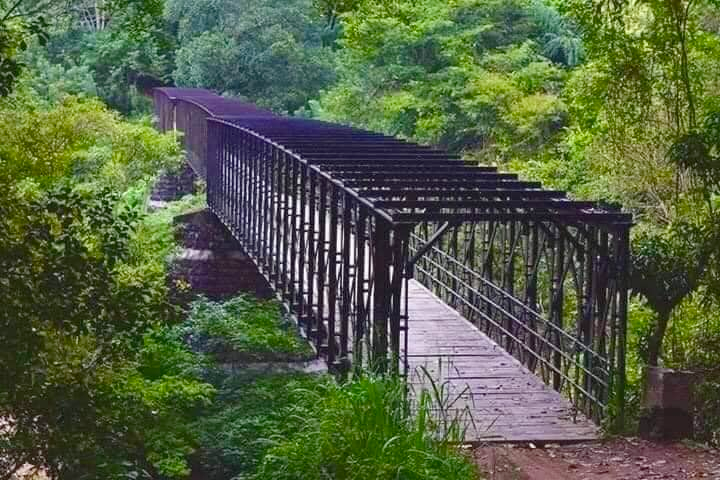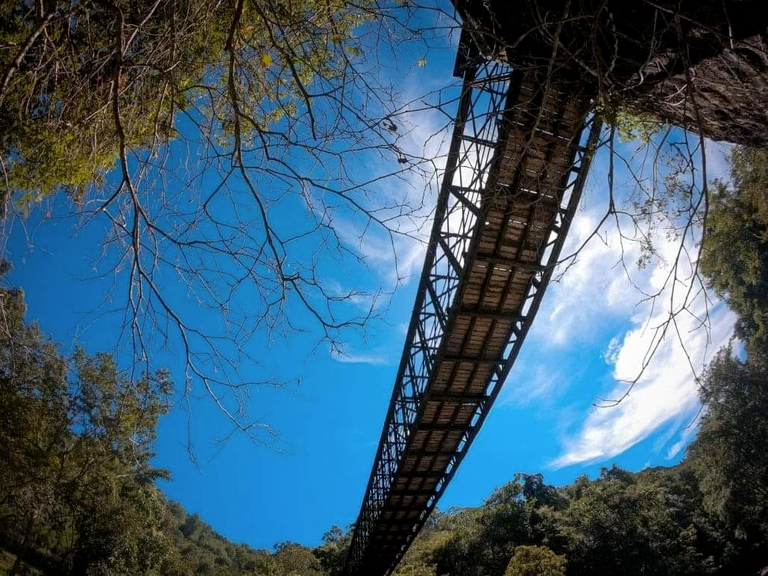The 'Halaba' bridge, built across the Uma Oya in the 'Halaba' area of Uvaparanagama, connecting the Uva Paranagama Divisional Secretariat Division and the Haliela Divisional Secretariat Division, is a wonderful design that was made during the British rule.

As a bridge to be built for railway lines, this bridge, which has been built entirely with iron arches, has used sleeper rods for its base.
It is 327 feet long and has been completed in three parts of 124 feet each. The width of the first and last sections is 10 feet and the width of the middle section is 8 feet.
A small board mounted on the upper arch of the bridge says in English that this bridge was built by the government factory in August 1919.
A very deep and wide place in Umaoye has been chosen for the construction of this bridge. At this place, the width of the river is about 300 feet, the depth of the river is about 25-40 feet, and the height of the bridge is about 100 feet.
One end of this bridge, which is located at the end of Uvaparanagama Thuppitiya Grama Niladhari Domain, belongs to Uvaparanagama and the other end belongs to Haliala.
E., a resident of Thuppitiya Allegama house array. G. Mr. Ariyapala - He explained about this bridge as follows. Our relatives have said that this bridge, which was supposed to be taken to Halawata and installed, was taken to Halaba and installed by mistake. We are also very surprised that this bridge was built here without connecting to any road.
There are two small footpaths on both sides. However, this is a wonderful design. It was made during the British rule in 1919. One rail weighs tons of iron. The sleeper logs placed at the base of the bridge are now decaying.
The pit under the bridge is about 40 feet deep. The height of the bridge is more than 100 feet. He said, "And from that day to this day, we have been demanding that this precious treasure should be repaired and repaired so that a vehicle can be driven on this dilapidated little road without allowing it to be destroyed."
About 100 feet from the bottom of Uma Oya
The view of the 'Halaba' bridge which is built high.
Among the amazing works built in Badulu district during the British rule, the Bogoda bridge (which was made entirely of wood), the Demodara arched 9 cloud bridge, as well as the very important Halaba iron bridge are precious and wonderful works that need to be preserved.
On Welimada - Uvaparanagama Maspanna road. m. 20 and turn at Bambarapana junction and turn onto Mahakumbura Road. m. It was even more difficult when I went to 7. m. When you arrive on the road around 3, you can see this 'Halaba' bridge.
You can reach this 'Halaba' bridge by coming to the Katawela junction from the Hali Ela side and coming on the Parani Raja Mawatha through Deegalle and then coming to the small side road.
There is no main road except small side roads on both sides of this bridge. It is a mystery why this bridge was built in this place without any connection to a main road.
And it is a big problem how these large iron tracks, concrete stones and large sleeper logs weighing thousands of tons were brought to this place for the construction of this bridge at a time when there were no roads or other facilities.
Looking at this design, you can imagine how much our ancient ancestors shed their blood and sweat and how many people sacrificed their lives to build this bridge.
It is a national duty to protect this precious and beautiful bridge from destruction and allow our future generations to see and use it.
There are three ways to see this bridge.
1- You can go to this bridge by going to Dala Mahakumbura Road from Bambarapana Junction on Welimada Maspanna Road.
2- Welimada Maspanna Road, a little ahead of Bambarapana Agricultural Service Center, you can enter from Madipokuna junction and go about a kilometer to the side road that leads to Halaba village.
3- From Badulla Haliela, go to Ketawala Junction and from there, after going a little towards Atampitiya, there is a side road and go towards Halaba... You can also go to this bridge.
So it is mentioned on this bridge that this Halab bridge was built in 1919.. then it is now 2020.. more than a hundred years.
How is the village?
If the bridge is maintained properly, it will be able to keep it for another thousand years.
So this is being built by connecting Uvaparanagama divisional secretary division and Halielala divisional division.. Sundara Uma Oya is flowing under it.. And this bridge is 372 feet.. that means 113 meters long.. Iron arches are used like train bridges and sleeper logs are built at the base. Also, this bridge will be built in three parts of 124 feet each.. The width of the middle part is eight feet.
So there are many beautiful stories about this majestic bridge king..
The first story is that he mistakenly brought a bridge to Suddon that was supposed to be built in Halawah, but he built it in Halawah
The second story - In the past, a railway line from Nanu Oya to Nuwara Eliya to Ragala had collapsed.
Wow, I asked today.. Yes, it really exists.. You can still see its ruins.
So the name of the railway line was Udupussallawa rail track (upr)..but that railway line only existed up to the railway station where Ragala was at that time..then why was it called Udupussallawa railway track?
This is where the incident unfolds..

At that time, Suddon had an idea to widen the railway line to Udupussalla and from there to Badulla via Halaba village.
#blurt #blurtstory #geekpranee #wrongly #people #srilanka #halavata #bridge
Congratulations, your post has been curated by @r2cornell-curate. Also, find us on Discord
Felicitaciones, su publication ha sido votado por @r2cornell-curate. También, encuéntranos en Discord